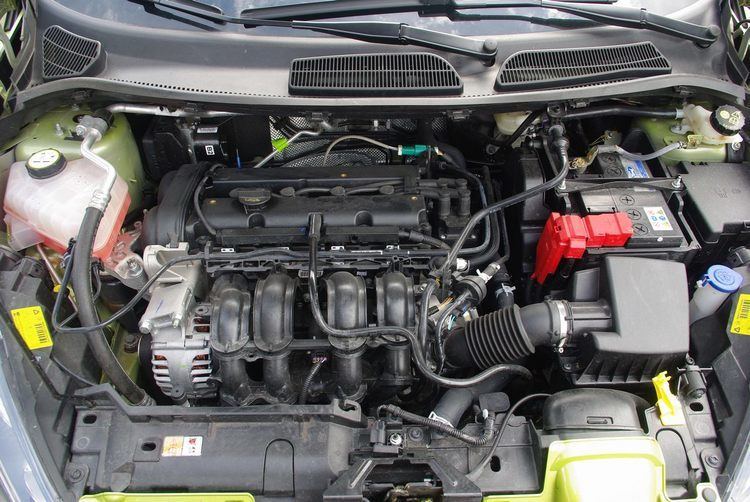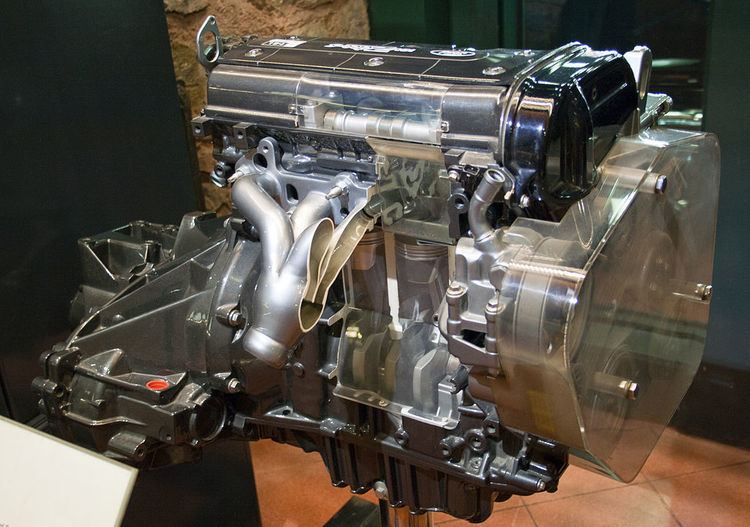Configuration DOHC straight 4 | Production 1995- Cylinder block alloy aluminium | |
 | ||
Displacement 1.25 L1.4 L1.5 L1.6 L1.7 L | ||
Introduced in 1995, the Ford Sigma is a small straight-4 automobile engine sold by Ford Motor Company. First evolution of engines were sold as the "Zetec-SE" (although frequently badged as Zetec-S, not to be confused with the trim level). After the upgrade Ford renamed Sigma to Duratec. Last upgrade of engine is named Duratec Ti-VCT. The engine was introduced in the mid-1990s and production continues through the present. Like the SHO V6 and SHO V8, the Sigma was designed with help from Yamaha. Conceived for Ford's smaller models, it was intended to replace the older HCS (a derivative of the even older Kent unit) and smaller capacity CVH units.
Contents
- Ford Sigma engine
- Introduction and Innovations
- Zetec S
- Zetec RoCam
- Applications
- Duratec
- Duratec Ti VCT
- Crate engine versions
- Current use
- Caterham usage
- SCCA Spec Racer
- Replacement
- References
The Zetec-SE has no common parts or design with the larger Zetec-E engines apart from the name. This gives rise to some confusion since it suggests that they are members of the same family, but are in fact, completely different. Zetec-E units are mounted transversely with the inlet manifold at the rear, whereas the Zetec-SE units are mounted with the inlet manifold at the front.
Ford Sigma engine
Introduction and Innovations

When the Zetec-SE first arrived in 1995 it included many firsts, such as a plastic inlet manifold, a "ladder" style main bearing and crankcase assembly, and big-end bearing caps which are forged in one piece and subsequently split. It also incorporates powder metal connecting rods, which were quite exotic and notable at the time. The engine first appeared in the Mk4 Ford Fiesta and the virtually identical Mazda 121 in 1.25L (1242cc) capacity, with 1.4 L (1388cc), 1.6 L (1596cc) and 1.7 L (1679cc) derivatives coming later.
Sigma engined is introduced under Zetec-SE name, after the upgrade it was renamed to Duratec. Latest upgrade of Sigma is called Duratec Ti-VCT.
Zetec-S
The 1,679 cc (1.679 L; 102.5 cu in) engines uses a heavily modified 1.6 L engine block and features Variable Cam Timing on the inlet camshaft. This Displacement has only been used in Ford Puma. 155 PS engine has only been used for the Ford Racing Puma with only 500 units built.
Zetec RoCam
In 2000, Ford of Brazil developed a cheaper version of the Zetec-SE engine, to compete with the classic Volkswagen EA827 engine series also known as AP (from "Alta Performance", or "High Performance", in English) engine in Brazil. It is 8v SOHC instead of 16v DOHC and its block is made of iron instead of aluminum. Also, its camshaft is driven by a chain instead of a belt. As a result this engine exhibits rougher behaviour, producing more vibration and noise.
On the other hand, it has a superb Torque output thanks to the addition of the RoCam (Rollifinger Camshaft) feature. It's also a much smaller engine than the SE version, which allowed it to be installed on the Ford Ka, replacing the Endura-E engine which by that time was considered underpowered and outdated.
The engine also featured a new patented process for the aluminum head production, which resulted in a better alloy than those produced in Spain and UK, and at a lower production cost.
In 2002 a supercharged 1.0 litre (94 hp; 95 PS) version was released for the Ford Fiesta, to compete with the 1.0 Turbo 16v (111 hp; 112 PS) version of the VW Gol.
In 2003 the Zetec RoCam engine was introduced in Europe, but labeled as Duratec 8v, for the SportKa, StreetKa and Fiesta. Later a 1.3 litre version was also released as an option for the standard model, but the European versions of the engine are produced in the South Africa plant.
In October/2004 a newer bi-Fuel version was introduced labeled "1.6L Flex", capable of running on both petrol and ethanol, even mixed at any proportion. This version also featured a high Compression ratio (11.8:1) and "Compound High Turbulence" chambers, as used on the CHT engine.
Currently, this engine powers nearly all Brazilian Ford models – except those with 2.0 litre engines – in many different variants:
Applications
1.6 L (1596 or 1597 cc/97 cu in) applications:
Duratec
Ford upgraded Sigma and renamed it to Duratec.
Duratec Ti-VCT
The 1,596 cc (1.596 L; 97.4 cu in) Ti-VCT (Twin independent Variable Camshaft Timing) version includes variable valve timing, and generates more power and torque than non-VVT counterparts. Latest versions comply with the Euro5 emission level.
Crate engine versions
Crate engine versions of Zetec-SE engines are sold by Ford Power Products under the name ZSG Range.
Current use
The Ford Sigma engine is produced at Bridgend Ford in Wales.
Today Sigma engine is used by Focus, Fiesta, C-Max and Mondeo. A 110 bhp (82 kW) version is used by Morgan for their 4/4 Roadster since 2009, albeit coupled to a Mazda transmission driving the rear wheels.
1.25/1.4/1.6 L Sigma
In the first-generation Ford Focus, the engines offered were capable of producing 75 and 100 bhp (75 kW; 101 PS). With the introduction of the MkII Focus, the 1.4-liter variant underwent slight modifications to increase its output to 80 bhp (60 kW; 81 PS). Both engine types are characterized by belt-driven camshafts and electronic fuel injection systems, and they each weigh 90 kilograms. The 1.6 Ti-VCT engine, introduced in 2004, features Variable Cam Timing and delivers 115 bhp (86 kW; 117 PS), specifically for use in the MkII Focus. A new 105/125 bhp EU5 version is used in the MkIII Focus, also a 1.6 L 120 hp (89 kW) version is used in Ford Fiesta Zetec-S. The Sigma is usually coupled to the Ford IB5 five-speed manual transmission.
Brazil
Today Sigma is present in Brazilian versions of Fiesta, Focus and Ecosport (1.6L TI-VCT version) and a 1.5 version is used by Ka. This engine is able to the flex technology.
Power with ethanol:
1.5L Sigma (non TI-VCT) - IB5+ manual transmission.
Fiesta (2014-2016) - 112PS Ka (2014-Present) - 110PS
1.6 Sigma (non TI-VCT) - IB5+ manual transmission (both) and PowerShift (Fiesta Only).
Fiesta (2008-2014) - 116PS Ecosport (2012-Present) - 116PS
1.6 Sigma TI-VCT - IB5+ manual transmission and PowerShift.
Focus (2013-Present) - 135PS Fiesta (2008-2014) - 128PS Ecosport (2012-Present) - 131PS
Caterham usage
Some Caterham Cars use Ford Sigma engines [3], such as the Caterham Seven 360, which as of 2016 uses a tuned Sigma engine which produces 180 hp (134 kW) at 7300 rpm.
Ford Sigma 1.6-litre overview Technical features:
SCCA Spec Racer
The third generation of the SCCA Spec Racer was introduced in 2015, and uses the 1.6 L Sigma engine. The engine is sold by SCCA Enterprises as a sealed unit.
Replacement
In 2012 Ford replaced the Sigma engine with a brand new 3-cylinder 1.0 litre EcoBoost engine for some markets and models. The new engine provides more power and torque with less fuel consumption and less CO2 emissions.
